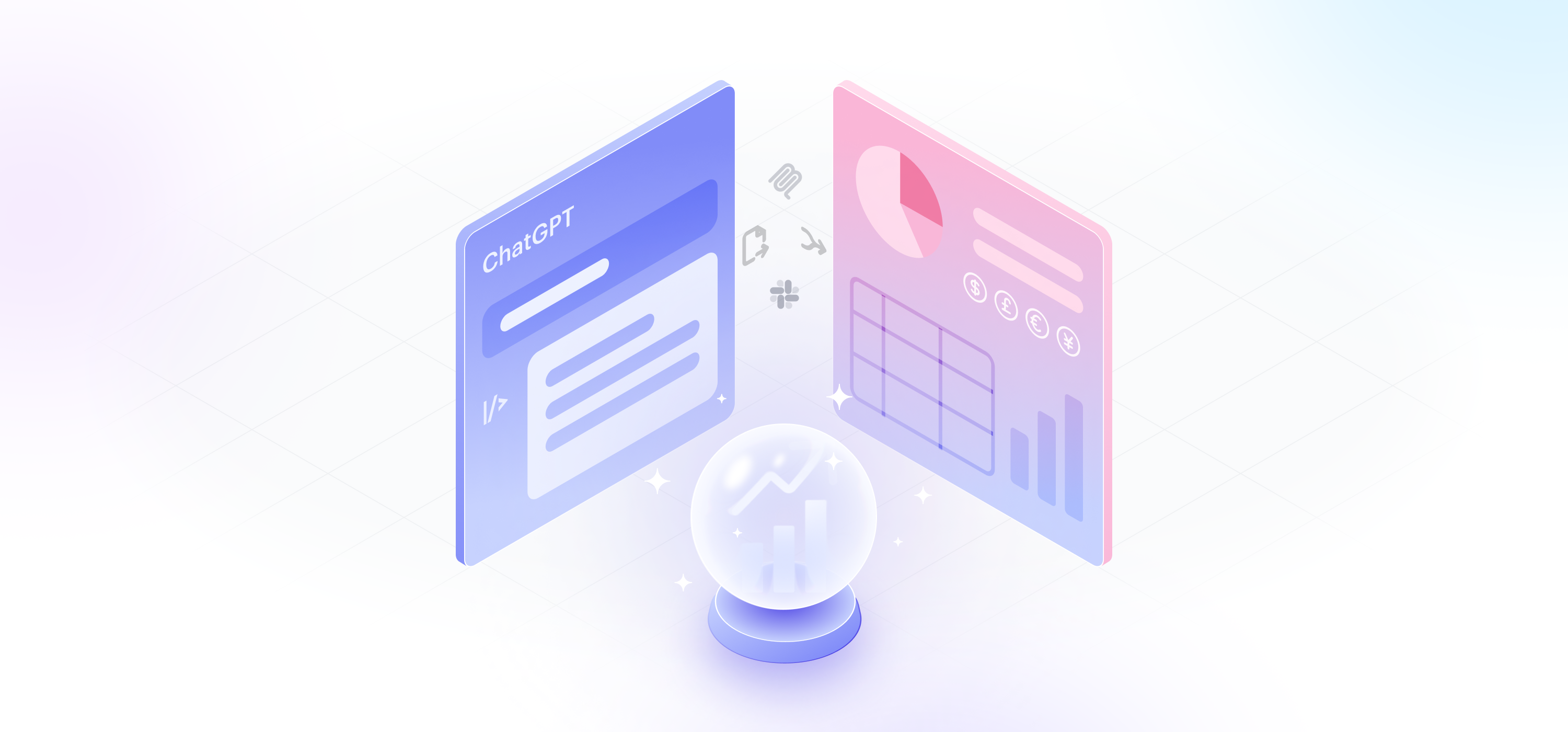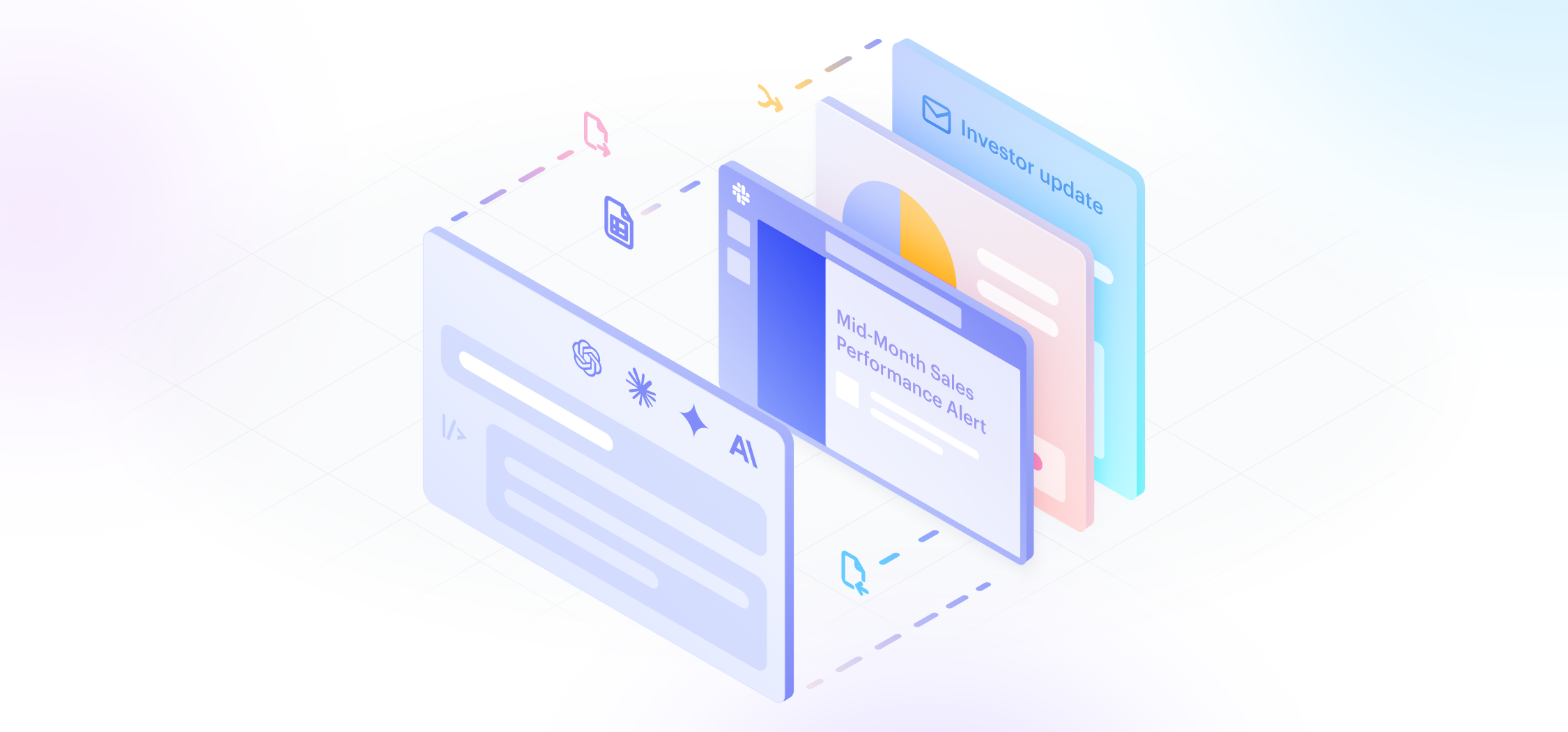Feeling lost in the AI hype? This comprehensive guide explores AI for finance, explaining 15 essential terms all CFO and finance professionals should know.
We'll explain how these technologies are transforming the world of finance and what the future holds. Reading this article won't make you an AI expert, but it will certainly help you become better prepared for the conversations you're having now or soon will have when you begin exploring what AI adoption might look like for your organization.
In the Iron Man movies, Tony Stark’s AI assistants, J.A.R.V.I.S. and F.R.I.D.A.Y., aren’t massive machines or algorithms. Rather, they are very intelligent systems that predict what Iron Man needs and when, quickly download and analyze complex information in seconds, and overall help him and the Avengers make smarter, calculated decisions. While finance teams today don’t have a system like Tony Stark’s, they can use AI features and finance tools to make their lives easier.
AI is changing how finance teams work. These tools can process vast amounts of data, identify patterns people might miss, and automate routine tasks that consume valuable time. In a 2024 survey, around 58% of CFOs have admitted to knowing very little about the use of AI in finance.
In 2025, many CFOs see the potential of AI but hesitate to go all-in because the unfamiliar “technology” can seem too complex or intimidating. The objective of this article is to provide you with a simple but solid understanding of key AI technologies so that you get onboard the AI trajectory with more confidence and clarity.
15 AI terms CFOs and finance pros need to know
Artificial intelligence is not just relegated to data analysts or IT teams any longer. CFOs and finance pros need to understand that AI in finance is no longer limited to standard automation tasks in accounting and finance teams.
As proactive and visionary business leaders, CFOs need to leverage the full power of AI for that competitive edge and effectively guide their teams (and organization) through the current wave of digital transformation.
Read on to know more about why AI in finance is the GPS of modern FP&A and how you can make informed decisions about AI adoption.
1. Artificial intelligence
Artificial intelligence (AI) broadly refers to systems and technologies that can perform routine tasks without constant human instruction or interference, such as data interpretation, logical reasoning, problem-solving, scenario analysis, and more.
In finance, AI is often working in the background of the many FP&A and automation tools you've heard of or possibly are using in your organizations, in the form of automated month-end close, predictive analytics, variance reporting, etc.
The biggest advantage of AI in finance is the ease of scalability. AI can interpret large amounts of data with more speed and accuracy than humans, thereby saving time and manual effort (prone to errors).
Artificial intelligence use cases in finance:
- Running month-end reconciliations without manual checks
- Flagging unusual changes in KPIs before you notice them
- Identifying and summarizing action items steps from meeting notes
2. Machine learning
Machine learning is a subset of AI that finds patterns in historical data and uses them to predict what’s likely to happen next.
You can think of it as the foundation of most AI tools marketed for financial forecasting, advanced or predictive analytics, even anomaly detection (discussed later in the article). Instead of applying fixed formulas, with ML, forecasts improve over time as it constantly “learns” from new data. This adaptability of ML makes financial planning more dynamic.
Machine learning use cases in finance:
- Improving the accuracy of your rolling forecasts
- Performing variance analysis by identifying which departments consistently overspend and when
- Managing accounts receivables and payables by flagging vendors or customers who show signs of credit risk
3. Extractive machine learning
Extractive ML doesn’t generate new content. Instead, it pulls useful information from disparate or unstructured sources, such as contracts, PDFs, and meeting notes. You don’t need to scan a hundred reports for EBITDA or hunt through leases for renewal terms. Extractive models can pull and arrange the data needed from those docs instantly for your consumption.
Extractive machine learning use cases in finance:
- Pulling key figures from subsidiary reports for group consolidation
- Extracting payment terms or notice periods from contract libraries
- Finding risk issues or next steps buried in finance meeting notes
4. Generative AI
Generative AI in finance creates new content based on the data it’s "trained" on. In FP&A, Gen AI is often used to interpret numbers with the help of commentary and text, such as generating variance explanations or budget narratives. You can use it to streamline financial reporting and planning cycles where the context—how and why it happens—matters as much as the numbers.
Generative AI use cases in finance:
- Describing the business rationale behind forecasts
- Predicting employee expenses or headcount requirements during budgeting cycles
- Describing planning scenarios (“If sales drop by 8%, what happens to our gross margin?”)
5. Predictive analytics
In the AI context, predictive analytics uses machine learning (and sometimes traditional statistical models) to forecast what’s likely to happen next, based on past behavior.
Unlike static models that rely on fixed assumptions, predictive tools adjust to new data automatically. This makes them useful for environments where conditions change quickly, for instance, sales cycles, hiring plans, or input costs.
Predictive analytics use cases in finance:
- Planning revenue based on historical trends and current pipeline activity
- Projecting benefits or payroll costs ahead of a hiring push
- Estimating capex spend patterns through year-end to help with liquidity planning
6. Large language models
Large language models (LLMs) are designed to understand, generate, and manipulate human language at scale and are commonly used in tools like ChatGPT.
In finance, LLMs work behind the scenes in reporting tools and planning systems, processing large volumes of text, explaining trends, summarizing documents, and converting notes or feedback into action items.
LLM use cases in finance:
- Summarizing 40-slide board decks into a few key takeaways
- Answering ad-hoc finance questions, such as “what happened to margin last month?” with data-backed explanations
- Translating department-level feedback into budget commentary that you can actually use
7. Natural language processing
Natural language processing (NLP) helps software understand and act on human language, even when it’s messy, unstructured, or inconsistent. It typically includes tools for classification, tagging, and sentiment analysis. LLM is a key component of NLP.
In finance, NLP is useful for processing unstructured inputs like emails, comment fields, supplier notes, and the like, into structured data that you can work with.
Natural language processing use cases in finance:
- Pulling key metrics from department updates or supplier emails
- Tagging budget comments that signal risk or confidence
- Converting narrative inputs into structured data for dashboards or reports
8. AI co-pilots, AI assistants, and intelligent assistants
These interactive assistants or features can be found within your finance systems, inside dashboards or spreadsheets, and help you get work done by summarizing data and responding to queries. You give them a prompt and they help with the execution.
While AI co-pilots aren’t about to replace human analysts anytime soon, they do reduce the time your team spends on clean-up duties—formatting reports, digging through spreadsheets, or second-guessing template logic. AI assistants enable your teams to be more productive and better utilize their time for strategic analyses.
AI co-pilots use cases in finance:
- Guiding teams through forecast builds (Example prompt—“What’s the last known value for Q3 headcount?”)
- Explaining KPIs within reporting tools and dashboards
- Helping with budget submissions for completeness via prompts
9. Agentic AI, AI agents, and autonomous agents
These are AI systems that can work on their own (autonomously)—but within defined boundaries. Unlike co-pilots, which respond to prompts, autonomous agents work in the background. They function continuously—running tasks, escalating issues, and ensuring processes keep moving, even when people are offline or otherwise engaged.
AI agents use cases in finance:
- Running rolling forecasts on a schedule and alerting you to significant shifts
- Monitoring spend across departments and flagging anything out of pattern
- Sending automated nudges to business units that haven’t submitted budgets
10. Autonomous process automation
The use of autonomous process automation (APA) in finance goes well beyond single task automation of an entire workflow or process.
Autonomous process automation can take on the whole workflow/process end-to-end, such as month-end close, from data consolidation and analysis to decision-making points. This kind of inherent efficiency removes the need for handoffs and manual review at every stage.
Autonomous use cases in finance:
- Automating the full month-end close process, including reconciliation and reporting
- Processing and approving vendor invoices without finance intervention
- Updating and redistributing cost center allocations after mid-cycle changes
Predicted trends for AI in finance
Artificial intelligence in finance is shifting its role from supportive to strategic. Already, over 25% of finance teams use some form of AI/ML in quarterly planning. Over the next few years, there is a high likelihood of finance teams adopting fully autonomous forecasting, where cash flow projections, revenue, and cost estimates update in real time as new data flows in.
Agentic automation is also expected to gain popularity. These tools will continue to build on AI that is currently used for client relationship management, tax and regulatory compliance, general automation, of course, and much more. Going forward, agentic AI can be used for reclassifying spend anomalies or triggering compliance checks based on predefined outcomes. This is already starting to show up in pilot implementations of continuous close, rolling forecasts, and spend monitoring.
Larger, enterprise-level finance teams will lean more heavily on AI-driven scenario planning and strategic advisory. AI tools will blend structured data with market signals to simulate complex outcomes, from capital allocation to M&A strategy.
Many finance professionals have begun to adopt some version of AI co-pilots and assistants for their-day-to-day tasks, including variance analysis, forecasting, and report generation. In the future, these finance insights engines are expected to independently gather data from multiple sources, reconcile discrepancies, and prepare comprehensive analyses without human intervention. Instead of spending hours preparing static reports, finance teams can ask questions like "What's the impact of a 5% increase in labor costs?" and receive immediate, detailed answers in multiple formats.
Drivetrain’s vision for AI
AI in finance often gets reduced to buzzwords. Drivetrain is different. Built as an AI-native FP&A platform, it delivers practical capabilities that CFOs can use right now to plan faster, forecast better, and act with confidence.
Drivetrain was built for this moment. We empower CFOs to turn AI into a competitive edge.
Here’s how Drive AI helps finance teams work smarter:
- AI Model Generation
Build complete financial models — from 3-statement to headcount to pipeline — in minutes. No manual formulas, no IT bottlenecks. Your team spends more time analyzing and less time building. - AI Transforms
Turn messy, raw data into clean, structured, analysis-ready inputs with a simple instruction in plain English. Data consolidation that once took days now happens in seconds. - AI Alerts
Always-on monitoring catches anomalies and errors early. Instead of learning about issues in the boardroom, you get proactive alerts in Slack or email before they become problems. - AI Analyst
Ask finance questions in natural language — “What drove margin down last month?” — and get immediate, data-backed answers. No waiting on manual reports.
Our vision for AI in FP&A and finance provides the user with control, clarity, and speed. Through the full suite of features and an interactive platform, Drivetrain automates all the regular operational tasks, flagging issues long before they become problems and explaining the logic and rationale of predicted outcomes. With Drivetrain, you get smarter forecasts, cleaner data, faster decisions, and fewer surprises.

Learn more about how Drivetrain helps CFOs resolve their most demanding finance challenges and build the future of autonomous FP&A.
Frequently asked questions
Currently, AI is being used to automate routine tasks, improve forecast accuracy, and streamline reporting. Finance teams are applying AI to speed up month-end close, consolidate budgets, detect anomalies, and generate narrative commentary.
Tools powered by machine learning are helping identify cost patterns and forecast revenue with greater precision. Generative AI in finance showing up in areas like variance explanations, executive summaries, and what-if scenario documentation.
Transparency and accountability are important. If your team is using AI to generate forecasts or allocate costs, you need to be able to explain how those decisions were made. Data privacy is another factor when AI tools process sensitive financial or employee data. Bias in models is also a concern. If your training data reflects past inconsistencies, the AI could reinforce them.
The solution is to apply governance: validate outputs, document assumptions, and make sure human oversight is built into your workflows.
AI improves forecasting by learning from historical data and adjusting as new inputs come in. Instead of relying on static models or manual adjustments, AI-powered forecasts update dynamically based on current trends, market signals, and business activity.
Machine learning models can factor in complex variables like seasonality, pricing shifts, or customer behavior and refine their outputs over time. The result is a more responsive planning process, with less reliance on gut feel or broad assumptions.
Your finance team needs data literacy, basic AI fluency and prompting skills, strategic thinking, and the ability to interpret and communicate insights.
The biggest challenge is usually data. AI tools need clean, structured, and accessible data to perform well but many finance teams still work across disconnected systems, legacy spreadsheets, or incomplete datasets. Integration is another hurdle, especially when trying to fit AI into an ERP or planning environment that wasn’t built for it.

.svg)






.webp)



.svg)

